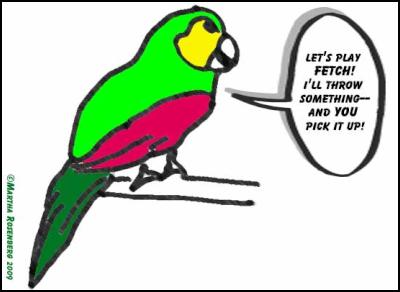Like Snowball, the dancing Cockatoo?
Like Snowball, the dancing Cockatoo? This Bird Shelter Has 37
by Martha Rosenberg
Chicago, Il

Click to enlarge
Rich Weiner was not among the 4 million Americans transfixed by YouTube's dancing cockatoo Snowball in May.
That's because 37 cockatoos and 39 other birds at the parrot shelter he operates in suburban Chicago similarly dance, talk and demonstrate intelligence.
When you visit A Refuge for Saving the Wildlife, the cockatoos, macaws, African grays, Amazons and other psittacines may not be steppin' to "Everybody" by the Backstreet Boys. But their spoken word performances--"Hello, Sweetheart!" and "What's Going On?"--convey that these pretty birds are pretty smart, too.
"Got The Paper?" asks one. "Shut Up!" answers another. One speaks in Lithuanian.
If it weren't for the empty cages in the driveway and red tail hawk in the back, the 11-year-old shelter and rescue facility looks like any other ranch style home found on a leafy street in the suburban community of Northbrook. But inside it sounds like a tropical rainforest and looks like a zoo nursery. Volunteers navigate the rows of cages which fill four rooms--tagged with instruction signs like "prefers women," "hard to get back in cage," "likes apples"--feeding, exercising and socializing their inhabitants unperturbed by 135 decibel calls. (A jet engine is 140 decibels)
Traverse a row of cages yourself and a fluffy white umbrella cockatoo will sidle over, extend his foot through the cage bars, "smile" with his pupils and crest, call you Sweetheart or Honey and win your heart.
Which is why shelters exist.
"People think cockatoos are cuddly and easy to take care of but they're not," says Weiner 50, a Glencoe police lieutenant when he's not running the shelter. "We tell them--if you want a bird that doesn't bite, doesn't poop, doesn't require care, patience, skill, money and frequent veterinarian visits, go to Toys R Us."
As a young police officer, Weiner had no plans to operate a bird rescue facility and become Chicago's unofficial Parrot Man. But after he grew attached to a companion African Grey and a cockatoo which he brought in the squad cars with him (in their carriers), people began giving him birds they couldn't keep. Pretty soon he had nine birds and found--when he couldn't keep them--that unlike dog and cat shelters, bird shelters didn't exist.
Of course today bird shelters exist--Snowball himself lives in an Indiana shelter--but few are as well run and with as strict adoption rules as A Refuge for Saving the Wildlife.
Think you can adopt a bird without a home visit? Without testing any other birds you have for the bird diseases of Psittacosis, Polyoma and Psittacine Beak and Feather disease?
Think you're "parrot companion material" because your parents let you have a parakeet when you were eight? Think A Refuge for Saving the Wildlife will ship a bird to you--or anyone? Dream on!
A quick look at A Refuge for Saving the Wildlife residents tells you why strict rules--and shelters themselves-- are necessary. One cockatoo battles cancer, heart problems and hypothyroidism after living with a smoker for 25 years. On six medications a day, he will not live out his expected 80 to 100 year life span, says Weiner. Another bird was found languishing at a pet shop; another called a drycleaners "home." No wonder the shelter's motto is: Don't Buy, Don't Breed, Please Adopt a Bird in Need.
Cockatoos are especially difficult companion birds says Weiner because they can be "clinging" and become jealous or temperamental-- though none are unadoptable he hastens to add; they just need the right home.
"In the wild these birds would spent 80 percent of their time foraging for food," says Weiner, seldom without a bird on his shoulder and often in surgical scrubs. "We can't recreate the perfect environment in captivity and they risk becoming 'perch potatoes.'"
In fact in between cages of sulphur-crested cockatoos like Snowball, umbrella and citron-crested, Goffin's and Moluccan cockatoos are cockatoos covered with nothing but a fuzzy white down--like baby chicks--due to the common nervous, addictive habit of feather plucking.
Still, for responsible adopters, a bird companion shares some similarities with a dog companion--but with a twist.
Like fetch? Parrots play "You Fetch"--throwing objects off the top of their cage or other surfaces for humans to pick whereupon they--what?--do it again!
Know your dog's "I see another dog" and "I want to go out" bark?
Birds have a "I'm glad your home" and "that sounds like my favorite food" call. (And if they like what you're eating they don't mist your knees like a dog, they dive bomb your plate.)
Does your dog block your TV screen to get your attention? Wait until your companion bird camps out on your computer keyboard. Notice me now?
Even a bird's definition of "toy" is as elastic as a shoe-loving dog, leaning toward the book you're reading (see: the bird ate my homework) or earrings you're wearing.
But of course birds outshine dogs at music, not just because they probably invented it but because they can dance on two legs without being held up.
Martha Rosenberg is a columnist/cartoon who writes about public health.


 Ramzy Baroud: Fighting Israel’s War In Jenin - Can The Palestinian Authority Be Saved?
Ramzy Baroud: Fighting Israel’s War In Jenin - Can The Palestinian Authority Be Saved? Binoy Kampmark: Far From Ignorant - The European Union, Arms Exports And Israel
Binoy Kampmark: Far From Ignorant - The European Union, Arms Exports And Israel Binoy Kampmark: Jimmy Carter, Israel And The Apartheid Question
Binoy Kampmark: Jimmy Carter, Israel And The Apartheid Question Richard S. Ehrlich: Pulverized By Asia's Tsunami
Richard S. Ehrlich: Pulverized By Asia's Tsunami Binoy Kampmark: Greenland Redux - Trump And America’s Continuing Obsession
Binoy Kampmark: Greenland Redux - Trump And America’s Continuing Obsession Ramzy Baroud: A Palestinian Year In Review - Genocide, Resistance And Unanswered Questions
Ramzy Baroud: A Palestinian Year In Review - Genocide, Resistance And Unanswered Questions